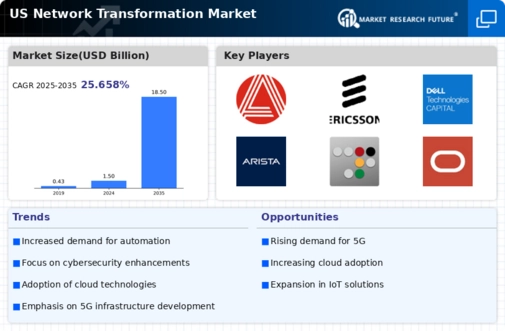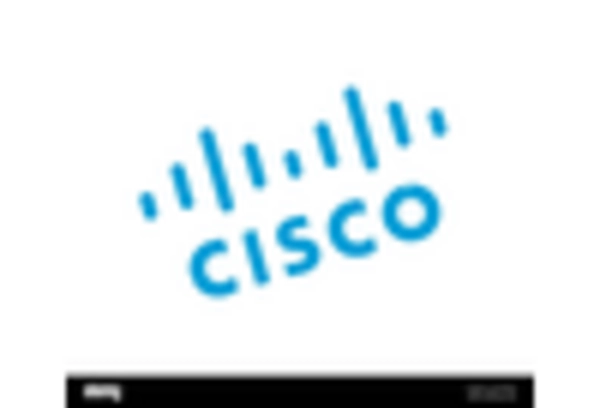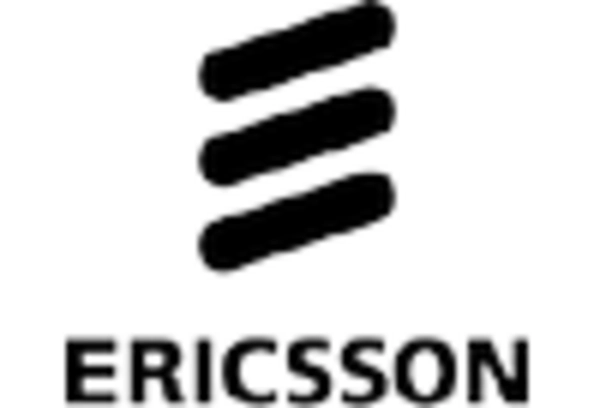Emergence of Edge Computing Solutions
The network transformation market is being reshaped by the emergence of edge computing solutions, which facilitate data processing closer to the source of data generation. This paradigm shift is driven by the need for real-time data analysis and reduced latency in applications such as IoT and autonomous systems. As organizations increasingly deploy edge computing architectures, the demand for network transformation is likely to escalate. Recent reports indicate that the edge computing market in the US is projected to reach $15 billion by 2026, underscoring the potential for growth in this area. By enabling faster decision-making and enhancing operational efficiency, edge computing is poised to play a crucial role in the evolution of the network transformation market, as businesses seek to leverage the benefits of distributed computing.
Increased Focus on Network Resilience
The network transformation market is increasingly characterized by a focus on network resilience. Organizations recognize the importance of maintaining operational continuity in the face of disruptions. This emphasis on resilience is driven by the need to safeguard critical business functions and ensure seamless connectivity for users. Recent surveys indicate that nearly 70% of IT leaders in the US prioritize network resilience as a key component of their digital transformation strategies. This trend is prompting investments in redundant systems, advanced monitoring tools, and disaster recovery solutions. As businesses strive to mitigate risks associated with network failures, the network transformation market is likely to see a rise in demand for solutions that enhance reliability and performance, ultimately leading to a more robust infrastructure.
Shift Towards Software-Defined Networking
The network transformation market is witnessing a notable shift towards software-defined networking (SDN), which offers enhanced flexibility and control over network resources. Organizations are increasingly adopting SDN to streamline operations and reduce costs associated with traditional hardware-based networking. This transition allows for dynamic allocation of resources, enabling businesses to respond swiftly to changing demands. Recent statistics suggest that the adoption of SDN solutions in the US has grown by over 25% in the last year, reflecting a broader trend towards virtualization and automation in network management. As companies seek to optimize their network performance and improve scalability, the network transformation market is likely to benefit from this growing inclination towards SDN, which promises to revolutionize how networks are designed and managed.
Growing Demand for High-Speed Connectivity
The network transformation market is experiencing a surge in demand for high-speed connectivity, driven by the increasing reliance on data-intensive applications. As businesses and consumers alike seek faster internet speeds, the need for upgraded network infrastructure becomes paramount. According to recent data, the average internet speed in the US has increased by approximately 30% over the past year, highlighting the urgency for network transformation. This demand is not only limited to urban areas but is also expanding into rural regions, where connectivity gaps are being addressed through innovative solutions. Consequently, service providers are investing heavily in fiber-optic networks and 5G technology, which are essential for meeting the expectations of users. This trend indicates a robust growth trajectory for the network transformation market, as companies strive to enhance their service offerings and maintain competitive advantages.
Regulatory Compliance and Data Privacy Concerns
The network transformation market is significantly influenced by regulatory compliance and data privacy concerns, as organizations navigate an increasingly complex landscape of laws and regulations. With the rise of data breaches and cyber threats, companies are compelled to adopt stringent security measures to protect sensitive information. Recent findings reveal that compliance-related investments in the US have surged by approximately 40% over the past year, as businesses seek to align their network strategies with legal requirements. This heightened focus on compliance is driving the adoption of advanced security protocols and encryption technologies within the network transformation market. As organizations prioritize data protection, the demand for solutions that ensure compliance with regulations such as GDPR and CCPA is expected to grow, shaping the future of network infrastructure.

















Leave a Comment